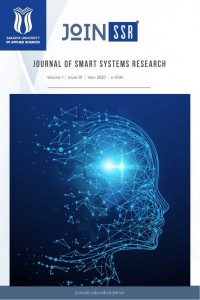Abstract
Teknolojinin gelişmesi ile birlikte insan vücudundaki sinyalleri algılayabilen sensörler geliştirilmektedir. Sensörler vasıtasıyla alınan sinyaller işlenerek çeşitli sistemler kontrol edilebilmektedir. Yapılan çalışmada Thalmic Labs tarafından üretilen MYO Armband ürünü ile EMG(Elektromiyografi) ve IMU(Inertial Measurement Unit) sinyalleri toplanarak endüstriyel robot kolunun kontrolü gerçekleştirilmiştir. EMG sinyalleri ilk önce ön işlemden geçirilmiş ve PCA (Principle Component Analysis) algoritması ile boyutu azaltılmıştır. EMG sinyallerini sınıflandırmak için Random Forest algoritması kullanılmıştır. Sınıflandırma sonucunda 3 farklı hareket tespit edilmiş olup bu hareketler ile endüstriyel robot kolu kontrol edilmiştir. Çalışmada ABB robot firmasına ait IRB120 endüstriyel robot kolu kullanılmıştır. Geliştirilen yazılım ile EMG ve IMU sinyalleri hareket ve konum bilgisine dönüştürülerek robot kolunun gerçek zamanlı kontrolü sağlanmıştır.
References
- [1]W. Cao, “Application of support vector machine algorithm based gesture recognition technology in human-computer interaction,”Informatica, vol. 43, no. 1, Jan. 2019.
- [2]K. Tanaka, K. Matsunaga, and H. Wang, “Electroencephalogram-based control of an electric wheelchair,”IEEE Transactions on Robotics, vol. 21, no. 4, pp. 762–766, 2005.
- [3]R. Bousseta, I. E. Ouakouak, M. Gharbi, and F. Regragui, “EEG Based Brain Computer Interfacefor Controlling a Robot Arm Movement Through Thought,”Irbm, vol. 39, no. 2, pp. 129–135, 2018.
- [4]Z. Lu, X. Chen, Q. Li, X. Zhang, and P. Zhou, “A Hand Gesture Recognition Framework and Wearable Gesture-Based Interaction Prototype for Mobile Devices,”IEEE Transactions on Human-Machine Systems, vol. 44, no. 2, pp. 293–299, 2014.
- [5]Z. Lu and P. Zhou, “Hands-Free Human-Computer Interface Based on Facial Myoelectric Pattern Recognition,”Frontiers in Neurology, vol. 10, 2019.
- [6]H. Tamura, T. Murata, Y. Yamashita, K. Tanno, and Y. Fuse, “Development of the electric wheelchair hands-free semi-automatic control system using the surface-electromyogram of facial muscles,”Artificial Life and Robotics, vol. 17, no. 2, pp. 300–305, 2012.
- [7]W.-T. Shi, Z.-J. Lyu, S.-T. Tang, T.-L. Chia, and C.-Y. Yang, “A bionic hand controlled by hand gesture recognition based on surface EMG signals: A preliminary study,”Biocybernetics and Biomedical Engineering, vol. 38, no. 1, pp. 126–135, 2018.
- [8]Mohammad, S., & Kumar, G. V. (2016, May). Development of sEMG based human machine interface control system for robotic watch. In2016 International Conference on Research Advances in Integrated Navigation Systems (RAINS)(pp. 1-5). IEEE.
- [9]Zhang, J., Wang, B., Zhang, C., Xiao, Y., & Wang, M. Y. (2019). An EEG/EMG/EOG-based multimodal human-machine interface to real-time control of a soft robot hand.Frontiers in neurorobotics,13, 7.
- [10]Sathiyanarayanan, M., & Rajan, S. (2016, January). MYO Armband for physiotherapy healthcare: A case study using gesture recognition application. In 2016 8th International Conference on Communication Systems and Networks (COMSNETS) (pp. 1-6). IEEE.
- [11]“Thalmic Labs,”The Lab. [Online]. Available: https://developerblog.myo.com/author/thalmic-labs/. [Accessed: 21-Jan-2020].
- [12]“ABB Robotics,”Manufacturer & Supplier of Industrial Robots. [Online]. Available: https://new.abb.com/products/robotics/. [Accessed: 21-Jan-2020].
- [13]L. Breiman,Machine Learning, vol. 45, no. 1, pp. 5–32, 2001.
Abstract
With the recent advances in technology, sensors that can detect signals in the human body are being developed. Various systems can be controlled by processing the signals received from the sensors. In the study, the control of the industrial robot arm was analyzed by using the MYO Armband device produced by Thalmic Labs, EMG (Electromyography) and IMU (Inertial Measurement Unit) signals. EMG signals are preprocessed first and the size is reduced with the PCA (Principle Component Analysis) algorithm. Then, Random Forest algorithm is used to classify EMG signals. Three different movements are determined from the classification result and the industrial robot arm is controlled with these movements. IRB120 industrial robot arm belonging to ABB robot company was used in the study. With the developed software, EMG and IMU signals are transformed into motion and position information, allowing real-time control of the robot arm
References
- [1]W. Cao, “Application of support vector machine algorithm based gesture recognition technology in human-computer interaction,”Informatica, vol. 43, no. 1, Jan. 2019.
- [2]K. Tanaka, K. Matsunaga, and H. Wang, “Electroencephalogram-based control of an electric wheelchair,”IEEE Transactions on Robotics, vol. 21, no. 4, pp. 762–766, 2005.
- [3]R. Bousseta, I. E. Ouakouak, M. Gharbi, and F. Regragui, “EEG Based Brain Computer Interfacefor Controlling a Robot Arm Movement Through Thought,”Irbm, vol. 39, no. 2, pp. 129–135, 2018.
- [4]Z. Lu, X. Chen, Q. Li, X. Zhang, and P. Zhou, “A Hand Gesture Recognition Framework and Wearable Gesture-Based Interaction Prototype for Mobile Devices,”IEEE Transactions on Human-Machine Systems, vol. 44, no. 2, pp. 293–299, 2014.
- [5]Z. Lu and P. Zhou, “Hands-Free Human-Computer Interface Based on Facial Myoelectric Pattern Recognition,”Frontiers in Neurology, vol. 10, 2019.
- [6]H. Tamura, T. Murata, Y. Yamashita, K. Tanno, and Y. Fuse, “Development of the electric wheelchair hands-free semi-automatic control system using the surface-electromyogram of facial muscles,”Artificial Life and Robotics, vol. 17, no. 2, pp. 300–305, 2012.
- [7]W.-T. Shi, Z.-J. Lyu, S.-T. Tang, T.-L. Chia, and C.-Y. Yang, “A bionic hand controlled by hand gesture recognition based on surface EMG signals: A preliminary study,”Biocybernetics and Biomedical Engineering, vol. 38, no. 1, pp. 126–135, 2018.
- [8]Mohammad, S., & Kumar, G. V. (2016, May). Development of sEMG based human machine interface control system for robotic watch. In2016 International Conference on Research Advances in Integrated Navigation Systems (RAINS)(pp. 1-5). IEEE.
- [9]Zhang, J., Wang, B., Zhang, C., Xiao, Y., & Wang, M. Y. (2019). An EEG/EMG/EOG-based multimodal human-machine interface to real-time control of a soft robot hand.Frontiers in neurorobotics,13, 7.
- [10]Sathiyanarayanan, M., & Rajan, S. (2016, January). MYO Armband for physiotherapy healthcare: A case study using gesture recognition application. In 2016 8th International Conference on Communication Systems and Networks (COMSNETS) (pp. 1-6). IEEE.
- [11]“Thalmic Labs,”The Lab. [Online]. Available: https://developerblog.myo.com/author/thalmic-labs/. [Accessed: 21-Jan-2020].
- [12]“ABB Robotics,”Manufacturer & Supplier of Industrial Robots. [Online]. Available: https://new.abb.com/products/robotics/. [Accessed: 21-Jan-2020].
- [13]L. Breiman,Machine Learning, vol. 45, no. 1, pp. 5–32, 2001.
Details
| Primary Language | Turkish |
|---|---|
| Subjects | Artificial Intelligence |
| Journal Section | Research Articles |
| Authors | |
| Publication Date | December 31, 2020 |
| Published in Issue | Year 2020 Volume: 1 Issue: 1 |


